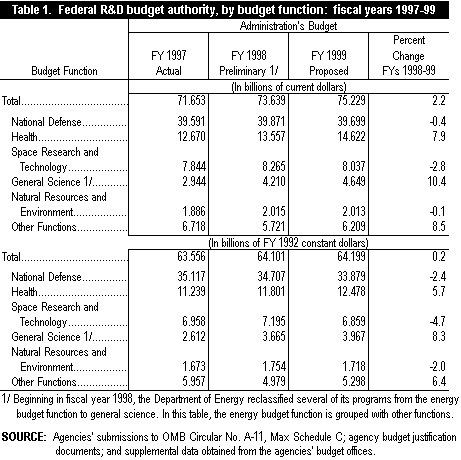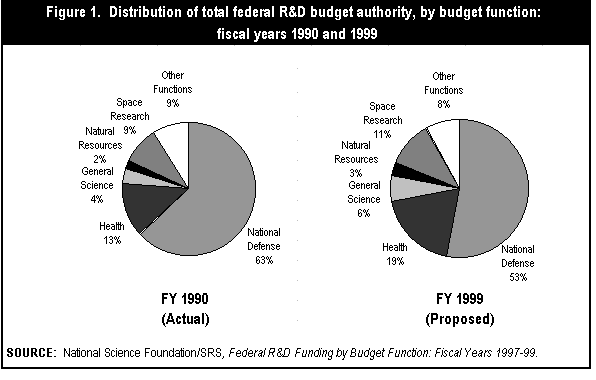| Division of Science Resources Studies | |
| DATA BRIEF |
Directorate for Social, Behavioral and Economic Sciences |
President's FY 1999 Budget Keeps R&D Spending at Last Year's Level When Adjusted for Inflation |
|
Throughout the 1990's, the percentage of Federal
R&D funding for nondefense programs continues to grow; nonetheless,
defense still accounts for more than half of the Federal R&D total.
|
The Administration proposed a total budget authority of $75 billion for R&D programs in its fiscal year (FY) 1999 budget, 2 percent more than the preliminary FY 1998 R&D total of $74 billion (table 1). After adjusting for expected inflation, R&D budget authority would remain flat. Details on Federal funding of the R&D components of agency programs for FY 1997 through FY 1999 will be available in the annual National Science Foundation (NSF) report, Federal R&D Funding by Budget Function: Fiscal Years 1997-99. 
This Data Brief presents the overall distribution and growth patterns of Federal funding of the research and development (R&D) components of agency programs, as proposed by the administration for FY 1999. The discussion focuses on the five largest mission area classifications with respect to R&D funding-national defense, health, space research and technology, general science, and natural resources and environment. These R&D budget function activities cut across agency lines. Although pending Congressional action will determine the final budget authority for R&D in 1999, the information presented here highlights Federal agencies' submissions to the Office of Management and Budget in early 1998. How Congress and the Administration affect the outcome of R&D funding levels will become apparent in 1999-2000. Proposed Defense R&D |

|
Health accounts for nearly one-fifth of the
Federal R&D budget authority - the largest share of the total nondefense
R&D.
|
R&D funding for the Department of Energy's (DOE's) atomic energy defense activities accounts for 7 percent ($3 billion) of proposed FY 1999 defense R&D. R&D funding for these DOE activities would increase 9 percent (a 7-percent increase in constant dollars) from estimated FY 1998 funding. DOE expects funding for weapons activities (including stockpile stewardship and stockpile management), its largest R&D atomic energy defense activity, to increase more than 19 percent (a 17-percent increase in constant dollars) above the FY 1998 level. By contrast, DOE expects fewer dollars for environmental restoration and waste management programs, down 37 percent (down 39 percent in constant dollars) and naval reactors development, down 1 percent (down 3 percent in constant dollars). Special technologies, nonproliferation, and nuclear safeguards and security will each be funded at their FY 1998 level (2 percent below their FY 1998 level in constant dollars). Proposed Nondefense R&D Among individual budget functions, health is slated for the largest FY 1999 R&D budget increase, $1 billion above the FY 1998 level. It would comprise 19 percent of the Federal R&D budget authority. Health-related R&D programs sponsored by the Department of Health and Human Services (HHS) would be funded at nearly $15 billion (an 8-percent increase above the FY 1998 level and a 6-percent increase in constant dollars). The bulk of the health account ($14 billion) will be allowances for programs of the National Institutes of Health (NIH). NIH's R&D funding for health activities is slated to increase by $1 billion or 8 percent (a 6-percent increase in constant dollars) in FY 1999. All 18 NIH institutes are slated to receive increases in their R&D budgets. Although the National Cancer Institute is slated to get the largest portion (over $2 billion) of NIH R&D dollars, two other units, the Office of AIDS Research and the National Heart, Lung, and Blood Institute, are each expected to receive more than $1.5 billion apiece. The National Aeronautical and Space Administration (NASA) proposed a 3-percent decrease (a 5-percent decline in constant dollars) in R&D budget authority for space research and technology activities, down to $8 billion. NASA reports reductions in all major R&D activities except life and microgravity sciences (up 7 percent) and space science (up 1 percent). The largest drop ($86 million) in the FY 1999 space research and technology account will be allowances for funding of the human space flight program, followed by a $64-million decrease in the space station program. Space research and technology would account for 11 percent of the total Federal R&D budget authority in FY 1999. The administration has proposed that research funding for general science increase by 10 percent, or more than $400 million in FY 1999, to nearly $5 billion. DOE contributed to this increase by reclassifying a number of its energy programs from the energy account to the general science account beginning in FY 1998. Had DOE not changed its appropriation account structure, general science research funding would have increased by $380 million in FY 1999, up 12 percent from a smaller FY 1998 base. In FY 1997, the National Science Foundation (NSF) accounted for three-fourths of these dollars. In FY 1998, NSF accounts for 60 percent, with DOE contributing the rest of the general science funds. NSF supports mathematical and physical sciences; geosciences; biological sciences; engineering; computer and information sciences; and social, behavioral, and economic sciences. DOE's major funded activities (each over $300 million) for general science R&D include support of basic energy sciences, high energy physics, and biological and environmental research. General sciences would account for 6 percent of the total Federal R&D budget authority. Natural resources and environment R&D is budgeted at $2 billion in FY 1999, no change from the FY 1998 level (but a 2-percent decrease in constant dollar terms). The Environmental Protection Agency (EPA) anticipates a 1-percent drop to $0.6 billion in its pollution control and abatement account, while the Department of Agriculture's Forest Service expects a 5-percent increase to $200 million in its conservation and land management activities. Five agencies provide support for R&D activities in natural resources and environment: EPA, which accounts for nearly 32 percent of the funding in this area; the Department of the Interior (31 percent); the Department of Commerce (nearly 26 percent); USDA (10 percent); and DoD's Army Corps of Engineers (2 percent). Natural resources and environment R&D would comprise 3 percent of the total Federal R&D budget authority. Data Collection Notes
This Data Brief was prepared by:
|